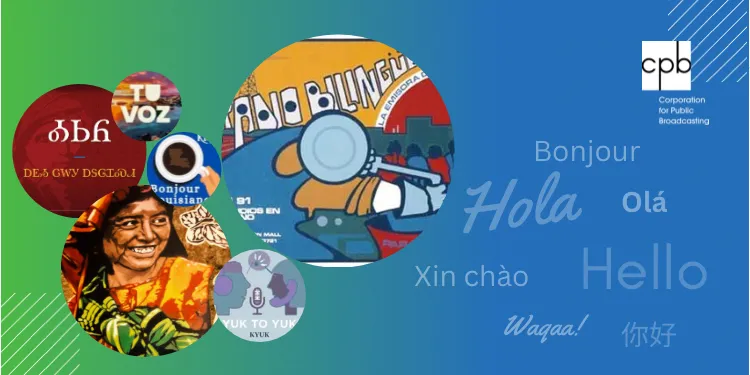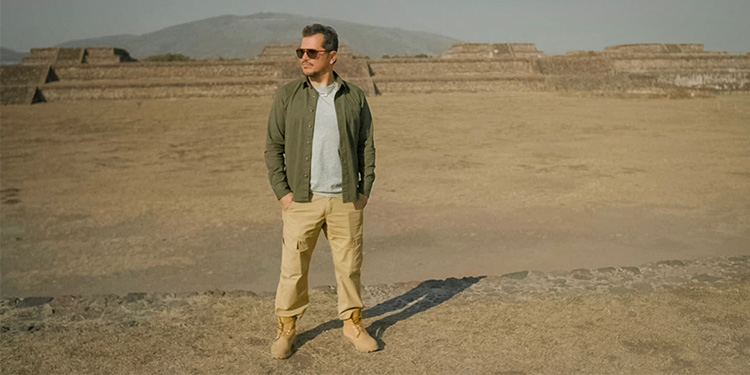October 26, 2022
Art, clockwise from top left: KRSU-TV Cherokee lesson, Claremore, OK; KUNR Tu Voz Spanish language app, Reno, NV; ‘Bonjour Louisiane’ radio show and podcast, KRVS, Lafayette, LA; Radio Bilingüe public radio network, based in Fresno; CA; KYUK’s ‘Yuk to Yuk’ Yup’ik language call-in show, Bethel, AK; ‘Buscando America,’ KBOO, Portland, OR.
Striving to reach all Americans with high-quality content that informs, educates, and enlightens, public media serves an increasingly diverse American society by producing content in at least 14 languages other than English. This work furthers the mission of the Corporation for Public Broadcasting (CPB) -- to ensure universal access to trusted content and services that help inform civil discourse essential to American society.
Public Media’s Breadth of Spanish-Language Content
According to U.S. Census Bureau estimates for 2021, 41.25 million people over age 5 in the U.S. speak Spanish at home. Public media reaches and engages this growing audience in all kinds of ways:
- At least 77 public media stations in 30 states, Puerto Rico, and the District of Columbia offer Spanish-language programming. They include community radio station KBOO in Portland, OR, which first aired the weekly radio magazine Buscando America more than 30 years ago, and KBEM in Minneapolis, which airs Paraiso Musical with music from the Spanish-speaking world and bilingual current events for three hours each Sunday.
- Latino public radio network Radio Bilingüe, based in Fresno, CA, owns and operates 13 full-power FM non-commercial stations in California, Arizona, New Mexico, and Texas and produces the only daily national Spanish-language news and public affairs programs in public broadcasting. Nearly 100 affiliate stations carry the award-winning journalism of Radio Bilingüe’s Noticiero Latino and Línea Abierta call-in talk show.
- NPR’s Spanish-language podcast Radio Ambulante builds community through in-person and virtual listening parties.
- NPR is partnering with Futuro Studios, the creative division of the Pulitzer Prize-winning Futuro Media Group, on The Last Cup, a dual language podcast using soccer to explore themes of identity, capitalism, immigration, class, and race. Jasmine Garsd hosts the podcast, premiering November 10 in anticipation of the FIFA World Cup, with episodes in English and Spanish.
- Boston-based GBH has partnered with El Planeta, the largest Spanish-language newspaper in Massachusetts, to produce and distribute Salud, a podcast and 30-minute radio show focused on health issues important to the Hispanic community. The Harvard Medical School Office for Diversity Inclusion and Community Partnership is providing expertise and guidance on medical matters.
- Among the national PBS content with Second Audio Program (SAP) tracks in Spanish are all of Ken Burns’ documentaries since 1994’s “Baseball.”
- 13 PBS KIDS series – more than 400 hours of content, or 37% of the library -- have Spanish SAP tracks available on air. PBS KIDS for Parents website is available in Spanish, as are an array of learning resources on PBS LearningMedia, a free online library of learning resources used by millions of teachers, parents, and students. Spanish-language PBS KIDS family resources are used to help parents learn English.
 Source: 2021 American Community Survey, U.S. Census Bureau
Source: 2021 American Community Survey, U.S. Census Bureau
News, Information and Public Affairs
- As part of the CPB-supported America Amplified engagement journalism initiative, six public media stations have embedded a Hearken widget to respond to voter questions in Spanish (WSHU, WNIJ, KJZZ, Arizona PBS, WITF, KUNR) and one in French (Maine Public) before the 2022 midterm elections. America Amplified also provides stations with Spanish-language audio and social media assets. Among participating stations, Maine Public translates news each week into Spanish, French, Portuguese, and Somali, as well as Arabic and Khmer in email newsletters through Maine Public News Connect, which hosts WhatsApp groups to connect and to engage. WSHU-AM/FM in Fairfield, CT, partners with Tu Prensa Local, a digital Spanish language outlet in Long Island, NY, to produce stories in English and Spanish. KUNR-FM partners with Noticiero Móvil, a bilingual student newsroom at the University of Nevada-Reno, to produce bilingual Spanish/English reporting, with Spanish language news available through Tu Voz, KUNR’s monthly WhatsApp newsletter. WNIN (Evansville, IN) and PRX produce ¿Qué Pasa, Midwest? Bilingual Reporting Network, sharing stories, news and more about Latinos in the Midwest through a podcast and WhatsApp. WNIJ in DeKalb, IL, produces Hola, a Spanish-language news, events and ideas hub. And KMUW (Wichita, KS), produces the weekly Radio Real Spanish-language podcast.
- Multiple public media stations offer bilingual voter guides and voter information, including Colorado Public Radio Voter Guide to the 2022 General Election, KQED’s California Voter Guide and guides to voting in Travis, Williamson and Hays counties offered by Austin, TX-based KUT. PBS SoCal and KCET offer the popular PROPS IN A MINUTE series of bilingual (English/Spanish) one-minute video explanations of California ballot propositions as part of KCET’s digital Ballot Brief.
- San Antonio-based Texas Public Radio provided real-time Spanish-language translations for its news coverage following the 2022 mass shooting in nearby Uvalde.
- Native Public Media supports a network of 57 Native radio stations and four television stations serving as an essential source of news and information in their communities, many of which broadcast at least some of their news programming in Native languages. These include KNNB-FM, Whiteriver, AZ, which reads daily announcements in the local White Apache language; and WOJB-FM in Hayward, WI, which offers a variety of Ojibwe language segments and sometimes translates public service announcements for help with taxes and pharmaceuticals. In 2021, Native Public Media led a CPB-supported campaign in which 36 stations provided trusted COVID-19 information in Native communities, including public service announcements in Native languages by Tribal elders.
- CPB-supported community radio station KFAI-FM in Minneapolis reaches a multicultural audience with programming in Filipino, French, Somali, Spanish, Oromo, Tigrinya, and Vietnamese. KFAI’s Sunday schedule includes four hours of public affairs programming in Tigrinya focused on the Horn of Africa (particularly Eritrea and Ethiopia) followed by two hours of programing in Somali, an hour of public affairs in Vietnamese and a half-hour of Filipino American news in Filipino.
- In Aspen, CO, KAJX produces a 60-second news report in Spanish that airs on LaTricolor Aspen, a Spanish-language outlet.
- KPBS in San Diego is one of five newsrooms participating in the American Press Institute Communities Sprint Program to expand their Spanish-language journalism content. The five-month program helps news organizations evaluate new strategies to build relationships with underserved communities, rebuild trust, diversify sources and coverage, experiment with new platforms, and deliver Spanish-language content.
Public Safety
In many states and counties, public media’s digital and broadcast infrastructure is the backbone for emergency alert, public safety, first responder, and homeland security services.
- Twin Cities PBS launched TPT NOW, the country’s first 24/7 TV channel broadcasting real-time, emergency alerts in English, Spanish, Hmong, and Somali.
- KYUK in Bethel, AK, translates emergency alerts into the Yup’ik language. Though there are less than 10,000 proficient speakers of Yup’ik, it is one of the only Alaska Native languages being spoken by children as a first language. KYUK is an example of how public media provides universal access even to remote communities.
- KUCB, serving Unalaska and the Aleutian Islands, translates emergency notifications with and for the Qawalangin tribe.
- WFDD in Winston-Salem, NC, began creating Spanish-language content during the pandemic to serve local audiences with critical public health information.
Cultural Preservation
Public media plays a key role in helping to preserve language and culture, from French Cajun to Alaskan Indigenous languages. There are 169 Native American and Alaskan Indigenous languages spoken in the United States today, many of which are listed by UNESCO as vulnerable or critically endangered languages.
- The podcast Mia’s Gift, from KSTK, Stikine River Radio in Alaska, teaches the Tlingit languages and aims to preserve the culture.
- The Voice of Denali podcast, from KRFF in Fairbanks Alaska, is a Native language preservation podcast with a word or phrase of the day presenting different dialects and language from rural Alaska.
- KOTZ in Kotzebue, Alaska, broadcasts Inupiaq stories every evening and maintains an avid listenership among the Elders in the community. The station translates PSAs and other news stories with Tribal Elders in mind.
- KYUK’s Yuk to Yuk is a weekly Yup'ik language call-in show featuring traditional knowledge, and conversations about current events and trends.
- KRVS, in Lafayette, Louisiana, has aired Bonjour Louisiane since 1981. The French language radio program and podcast features French Cajun music and is a morning ritual in Louisiana and around the world.
- Stations are also archiving culturally significant programming. More than 220 episodes of “En Français,” which aired entirely in French 1980-1993 on Louisiana Public Broadcasting, is available online at the American Archive of Public Broadcasting.
Education
Public media also supports language acquisition.
- KUEN in Salt Lake City, Utah, provides online language education instruction in Spanish, French, German, American Sign Language, and Mandarin Chinese, used widely by homeschool students across Utah.
- In partnership with the Cherokee Nation, RSU Public TV (KRSU in Claremore, OK) offers beginner classes in the Cherokee language airing three times a week on RSU Public TV Channel 35.2 and available on demand. The classes are part of a certificate program and can also be taken for college credit at Rogers State University.
- NPR’s Radio Ambulante partnered with Jiveworld on Lupa, a mobile app that combines Radio Ambulante stories with tech features to help intermediate Spanish speakers become more fluent.
- PBS LearningMedia, a trove of K-12 digital educational resources available to teachers and students for free, includes resources on Spanish, Japanese, French, German, and Chinese. They include lessons, videos and supplemental resources linked to state standards.
To subscribe to CPB spotlights, press releases and grant announcements, go to cpb.org/subscribe.




